Maintaining a truffle plantation / Growing a truffle plant
• The history of Black Truffle growing
• The different types of Truffles
• Choosing the right truffle...
• How truffle trees are produced ?
• Choosing your Truffle Tree
• Planting density of truffle trees
• Soil preparation to Creating a Truffle Plantation
• Planting Truffle Trees
• Maintaining a truffle plantation
• Harvesting the truffle
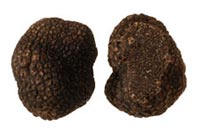
The management of a truffle « orchard » is very different from the arboriculture involved with fruit trees. You need to look after both the tree and the fungus at the same time. The tree effectively acts as the plant support on which the fungus develops. It is therefore necessary to assure that the tree develops its roots properly and that it is in good health. Likewise, the fungus that produces the truffle must also be cared for. It lives in symbiosis with the tree and needs to grow correctly. Every time that you intervene remember these two facts (do not use a fungicide for example).
You should try to adopt a well thought out approach to the culture only helping nature when it is necessary.
In any case, always ensure that:
- The host plant has good root development with a steady growth.
- The fungus is able to live in symbiosis with the tree's root system and to properly colonise the soil.
Truffle culture primarily involves three main phases, each of which needs to be managed differently:
- The settling in stage of the plant
- The fungus development stage
- The fruiting stage
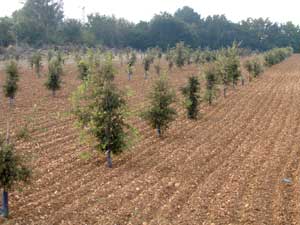
The settling in stage of the plant
This lasts between 1 and 3 years, depending on how quickly the plant grows. It is essential during the first year after planting to ensure that the plants have settled in and taken: it is a good indication that the trees will continue to grow well during the next few years. It has also been proven that the subsequent truffle production is better on trees that have grown well in the first three years and not vegetated. During this settling in period, it is important to encourage the plants to produce as many small secondary roots as possible. It is on these small secondary roots that mycorrhizae will establish themselves and begin their mycelian activity.
To make sure that this happens, the soil around the young plants must be properly prepared. The ground must be aerated, weeded, reasonably damp and free from all competing fungi and parasites.
Soil maintenance (weeding and aerating)
Lightly work the soil between the rows. In the rows carry out weeding either by mechanical means or by using chemicals. If you use mulch then this step is not required.
Lightly hoe the surface.
Watering
When you carry out watering, it is crucial to bear the following points in mind:
The type of plant: the oak has a deep root system and is less sensitive to drought than the hazel, which has a shallow root system.
The needs of the fungus: the truffle is xero-thermophile, meaning that it likes heat and dryness. An excess of water is more harmful than a lack of it. The aim is to keep the root ball moist but without it being wet.
The period of the year and the planting time:
- during the dormant winter period, the plant needs no water
- for late plantings and at the start of the growth period in the spring, from April onwards the plant's need for water is high: 3 to 5 litres of water per plant is required. This amount will vary depending on the type of soil :
- On stony soil: water should be given every 10 days during the season.
- On clay soil: water every 20 days.
Be careful, we must not lose sight of the fact that we are trying to educate the plant's roots: a plant that is given water will not make any effort to look for its own nutrients and will therefore not produce worthwhile roots. Watering should be complimentary but it should always be nature that undertakes the work.
Pruning
The Périgord truffle needs an open and sunny position. The first formative pruning takes place between the second and fourth years in February/March (after the last frosts). All excess vegetation around the base of the tree is removed especially suckers. This pruning style is called « upturned cone ». Even in the south of France where there is a lot more sun and therefore less branches need to be cut off than in the North, we should still aim to clear the bottom 20% to 25% of the trunk.
The Bourgogne truffle prefers shade and therefore pruning is not needed.
Parasites that attack young truffle plants
Parasites are the enemy of young plants. As they are still not very big they are unable to defend themselves efficiently. During the first years, you must watch out that disease does not end up wiping out your cultures. Fungicides must obviously be used with great caution because of the fungus and mycelium that you are growing.
| Parasites | Description of the symptoms and risks | Cure |
| OIDIUM (fungus) |
- leaves covered by a white mycelian coating - weakening of young plant (establishment, growth) that indirectly harms subsequent mycorrhization |
- chemical prevention, spray the plants with micronized colloidal sulphur between end of May and mid June. -use a non systematic fungicide such as Dinocap (Karathane) |
| CATERPILLARS (leaf eating) |
- from April onwards the caterpillar will fold over the leaves to build a nest in which to put its larvae - if the attack is significant then photosynthesis is reduced and the young plant will weaken |
- as soon as the caterpillars appear often coinciding with the arrival of the leaves, treat the plant withPhosalone (Zolone ®) or with Diflubenzuron (Dimilin ®) |
| TORTIX VIRIDANA (Green oak moth) Aphids, greenfly | - this caterpillar bores a hole into the trunk or branches | - as soon as the caterpillars appear often at the time of the first leaves : carry out 2 treatments with either Phosalone (Zolone ®) or with Diflubenzuron (Dimilin ®) |
| ZEUZERA (leopard moth) |
- originates from seeds : variety Negret with small fruits - dry and dead branches |
- push a metal wire into the gallery to kill the caterpillar - cut off the infected part of the branch containing the larvae |
| MOTHS (leopard moths) |
- the caterpillars make holes in the leaves – the epidermis of the leaf detaches along the entire length, withers and falls off - if the attack is significant then the photosynthesis is reduced and the young plant weakens |
- products and treatments against leaf eating caterpillars are very effective |
| RUST (fungus) |
- brown stains appear on the leaves towards the end of summer and cause the leaf to dry out. - if the attack is significant then the photosynthesis is reduced and the young plant weakens |
- spray with bordelaise solution (200 g of copper metal / hl) as soon as the symptoms appear |
| Parasites | Description of the symptoms and risks | Cure |
| 2) HAZEL TREE : BACTERIA |
- dead brown parts at the end of shoots and on the knots - canker of the lateral green shoots and old buds leading to drying out of the stem |
- spray with bordelaise solution (200 g of copper metal / hl) before the leaves appear and in autumn -remove all cankerous branches by harsh pruning. |
| WOOD BORING INSECTS | - the larvae bore holes in to the trunk and branches leading to drying out of branches | * If the damage is serious treat with phosalone based products (Zolone ®) |
IMPORTANT: Never use a fungicide or insecticide with a systematic action, as it will destroy the mycelium of the fungus.
The amount to use of each product depends on the strength and specifics of each brand. Always read the instructions for the products.
The development stage of the fungus (burnt circle)
This occurs from the fourth year onwards, once the trees are well established and a burnt circle appears around the base of the tree: it is a sign that there is strong mycelian activity. The truffles are now not far off! Note that these burnt circles will be more noticeable and occur earlier on light soils than on rich ones and with Holm Oaks more so than with other species.
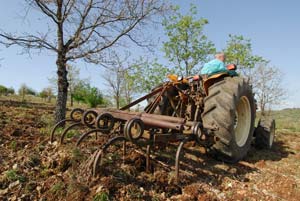
Soil preparation
Any intervention should be carried out so that it is in harmony with the ecological cycle of the truffle.
From the end of May until the end of the harvest in March, the soil must not be worked or driven over with machinery.
The soil in the truffle plantation must be well aerated. It is one of the key criteria for success.
If the soil is compacted (clay soil) then there is little chance of harvesting any truffles. Any soil work that needs to be carried out should be done using a tiller and at no more than 5 to 10cm deep. You should always work in the same direction to avoid damaging the roots. It is a good idea to progressively work further away from the tree as it gets bigger to decrease the risk of disturbing the mycorrhizae.
If the soil is naturally aerated and it is decided to work on it further, then it should be restricted to between the rows to reduce any competition from weeds. The use of a brush cutter for clearing should be sufficient.
Working the soil effectively eliminates the roots of flowers. This means that the truffles tend to be slightly deeper than if the soil had not been worked. They are therefore less affected by climatic variations.
Attention, it is important to note that the choice of how to work the soil must be made right at the start of creating the truffle orchard. It cannot be changed. Any dramatic changes in the management of the truffle orchard can drastically reduce the yield of the future truffle harvest.
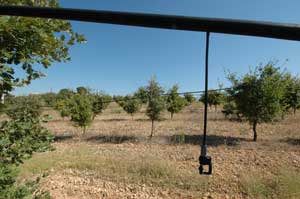
Watering
We are talking here about maintaining soil dampness.
It means keeping the soil moist to help the proliferation of the mycelium and stimulate mycorrhizing activity amongst the small secondary roots, so that the first truffles will be created at the start of the summer. Be careful not to over water otherwise the roots may asphyxiate, excess watering can also cause competing mycorrhizae or the development of other types of truffle such as Tuber brumale. It is important to know your soil's characteristics and keep an eye on how dry the top 20cm are, as this is where the truffles will be found. It is also important to record the level of rainfall using a rain gauge that is put in an open space.
Any irrigation should be done to compensate for water deficiency. If the winter has been particularly dry, it might be necessary to water the plants from April onwards to benefit from the warming up in spring and stimulate the mycelian activity. In summer watering can be more or less frequent depending on the weather and type of soil and nutrients (2 to 3 times a month), each watering should compensate for a lack of between 20 to 30 mm of rain.
Any irrigation should also take into account the ability of the soil to retain the water : a stony soil drains freely and likewise a clay soil is very retentive.
Weeding
As regards the truffle we recommend being as ecologically friendly as possible, it is therefore not essential that the truffle orchard be totally weed free. Around the plants, the burnt circle phenomena will kill off any weeds. In between, the rows use a brush cutter for clearing. However do not overdo it; if you are caught out by the weather and time, then the some types of weed killer can be used for small areas.
Fertilizers
A soil analysis every three years will allow you to know the exact chemical and organic composition and allow any adjustments to be made. The laboratory's report will show exactly which fertilizers are needed to improve the soil.
Remember that as from the end of May /beginning of June, the truffle will be independent of the host plant and will therefore need its own source of nutrients to survive and prosper until the winter. It appears to need plenty of organic nutrients during this period.
A good rule is to be prudent, it can be dangerous to meddle too much and overdo things.
Before using a fertilizer on a large scale, it is a good idea to try it first on a few trees and to observe the results. If you are worried about the quality of the truffles, it is important to check the level of calcium in the soil and add some if needed (crushed limestone).
Pruning
The young plants will have been trained at the start. Thereafter the essential thing is to keep the base of the trees open and make sure that the lateral branches to not intrude in to the space between the rows, always keep in mind the image of the « upturned cone».
Hazels are more laborious to prune, they can be grown with several main stems as long as it keeps the tree open and allows plenty of sunlight to reach the ground, this helps it warm up in the spring.
Disease treatments
As the trees reach adult age and size they should be less bothered by parasites which might threaten their life.
On the other hand, if the trees grow too quick, they can be affected by a parasite that slows down this excess growth (common oak, white oak, hazel)
The most commonly observed parasite on oak is oidium, which shows itself via a white powder on the leaves and a general weakening of the tree. It can be treated using non systematic fungicides containing sulphur or Dinocap.
On hazel trees, the most common disease is due to bacteria whose signs are dead parts of the stems and drying out of the branches. There is no chemical cure. The only solution is to cut out the affected branches and burn them to avoid any further risk of infection. Also disinfect the blades of the secateurs that were used to cut the diseased branches.
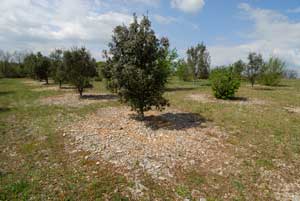
Fruiting stage
Around the eighth year or possibly before in the case of the Holm Oak or Hazel tree, you should start to get your first truffles.
This is no longer the time to think about training your dog but the time for putting him to work ceaselessly in the plantation.
Despite everything else, there are still jobs that have to be done:
Soil preparation
A light turning over of the soil if is compacted. The truffles will be bigger if the soil is loose. This should be done with a hand cultivator and always to the same depth. The period for carrying out the work is the end of March/April once the truffles have been harvested and the before the new ones start towards the end of May. This will help the spring rains to get into the ground and the summertime evaporation will be reduced. At the same time cut back any excess vegetation and weeds that may compete with the developing truffles.
Watering
« A summer without rain is a winter without truffles ». Throughout the course of the production cycle, proper watering will help achieve a good truffle harvest and keep the mycorrhizae alive. You must never forget that excess watering is as dangerous as a lack of water and it risks destroying your truffle plantation. In the same way that care was taken over the introduction of the truffle fungus, care must be taken to ensure that the watering suits the stage of its ecological cycle and the type of soil that it is in.
In May and June: as the new truffles start to grow, about 30mm of water a month given in 2 or 3 doses should be sufficient, this is dependant on how dry the spring has been. This way we encourage the maximum number of new trufflettes.
In July, the truffle grows very little and watering is less important. However if there is a heat wave, try to make sure that the ground retains a certain humidity to keep the new truffles alive: the use of a mulch might be suitable to reduce the loss of water and protect against the heat.
The crucial moment is the first fortnight of August when the truffle enters a growth stage and increases its weight by 10 to 15 times from some centigrams to a few grams. At this time, about 60mm of water in 2 or 3 doses a month is advised. As the old proverb says « if it rains on the day of Saint Roch (16 August), then the truffles will grow on rock! ».
The end of the season must not be neglected either because in September and October the truffle continues to grow. 60 mm of water in 2 or 3 doses for September and about 30mm for October should assure a good quality of truffle in the ground.
In November and December, the truffles enter their mature phase as the first autumn frosts arrive: you must now refrain from watering as you might cause the truffles to freeze. A mulch made with clippings or straw will help limit any damage from the frosts.
Pruning
Carried out in winter, it will prevent the truffle plantation from shutting down too quickly and production falling off. If the truffle plantation is densely planted and cultivated intensely, it is a wise idea to prune harshly at each stage, especially the white oak.














































































































































































































































